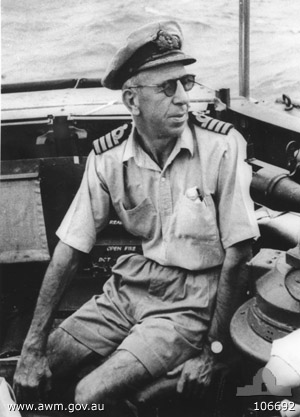|
World War 11 Casualties
| |
|
If you could spare
a few dollars to help with the running costs of
this website would be
very much appreciated.
Thank you from
Gravesites of Tasmania. |
|
Dechaineux Emile Frank V
 Emile
Dechaineux, born at Launceston in Tasmania
on 3 October 1902, reached the pinnacle of his naval career when he was
given command of the heavy cruiser HMAS
Australia in 1944.
Dechaineux's career began when he entered the
Royal Australian
Naval College
at Jervis
Bay ,
Federal Capital
Territory , in 1916 at the age of 14. He
graduated three years later and was promoted to midshipman in 1920. Emile
Dechaineux, born at Launceston in Tasmania
on 3 October 1902, reached the pinnacle of his naval career when he was
given command of the heavy cruiser HMAS
Australia in 1944.
Dechaineux's career began when he entered the
Royal Australian
Naval College
at Jervis
Bay ,
Federal Capital
Territory , in 1916 at the age of 14. He
graduated three years later and was promoted to midshipman in 1920.
Dechaineux travelled
to England to
undertake sea and shore training with the Royal Navy before returning to
Australia in 1924. He served on HMAS
Brisbane that year, was promoted to lieutenant, and
in 1925 transferred to HMAS Melbourne
, before returning to
England in 1926. He qualified as a
torpedo officer and naval air observer and returned to
Australia , serving on several more
ships and being promoted to lieutenant commander in September 1932.
Three years later he was appointed Squadron Torpedo Officer in HMAS
Canberra ; he was in that post when he
married Mary Harbottle in 1936.
A third journey to
England followed in 1937 when Dechaineux attended
the Royal
Navy Staff
College ; he was promoted again, to
commander, in June. He served in the British Admiralty's Tactical and
Minesweeping divisions until April 1940 and made five trips to assist in
the evacuation at Dunkirk
as the commander of the destroyer HMS Vivacious. Dechaineux was
then given command of HMS Eglinton, and operated on
North Sea patrols. He was awarded the Distinguished Service
Cross in 1941.
Dechaineux returned
to Australia
that year to become Director of Operations at Navy Office, Melbourne. In
June 1943 he was given command of Task Force 74 with tactical control of
a destroyer formation that included US naval vessels. In command of HMAS
Warramunga, Dechaineux operated in Australian and New Guinean
waters, assisting in amphibious landings around
New Guinea and in the
Admiralty Islands . He was promoted to captain on 31
December 1942.
On 9 March 1944
Dechaineux was given command of the flagship of Task Force 74, HMAS
Australia . Under his
command, Australia
supported Allied landings at Hollandia in Dutch New Guinea and at the
islands of Biak, Noemfoor, and Morotai; by October his command had taken
him to the
Philippines . On the 21st of that
month Australia
was supporting American landings at Leyte Gulf
when she was struck in the foremast by a Japanese dive-bomber. The
subsequent explosion and fire engulfed
Australia 's bridge. Shrapnel
disembowelled Dechaineux; he survived just a few hours and was buried at
sea that night.
Dechaineux had been a
highly regarded naval officer - winning promotions ahead of his
contemporaries - and was expected to attain a senior command post.
Subordinates considered him a decent man and fair captain quick to
praise effort and initiative but not hesitant about punishing
transgressions. The
United States government posthumously
appointed Dechaineux an Officer of the Legion of Merit and in 1990 the
Australian government honoured him when it named a new Collins-class
submarine the HMAS Dechaineux.
Our
thanks to the Australian War Memorial for permission to reproduce this
article
http://www.awm.gov.au/people/157.asp
|

